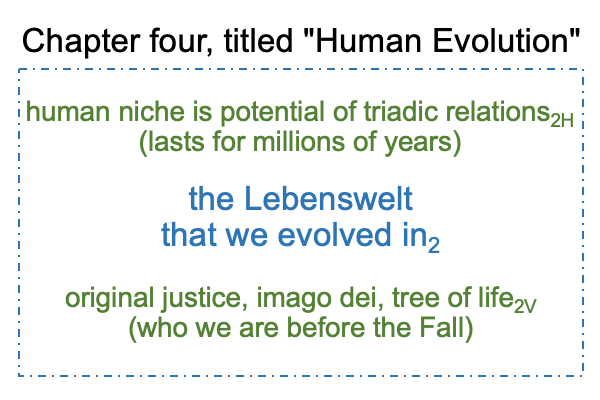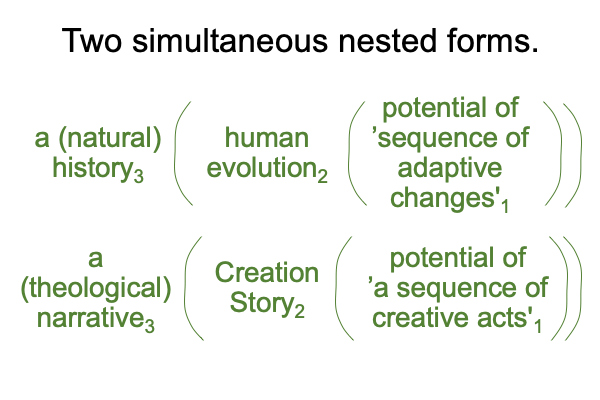0050 In the past three blogs, I discuss how chapters three and five of Haarsma’s work, titled, “Suffering and Death Before Humans (er… Adam and Eve)” and “The Soul, the Imago Dei, and Special Divine Action”, stand on either side chapter four, titled, “Human Evolution”.
Here is a picture of the core of the intersection associated with chapter four.

0051 Chapters three, four and five constitute a pattern, C:D:C’.
Plus, these three chapters point to the Creation Story.
The Creation Story turns familiar conclusions around.
Since Adam and Eve are denied access to the tree of life, and since Paul says that sin and death enter the world with Adam’s transgression, then a believer may readily conclude that suffering and death do not occur before Adam and Eve.
The intersection of chapter four suggests otherwise. The Homo genus evolves in a world full of suffering and death. This is the world of the Creation Story. The imago dei is what we evolved to be.
0051 Chapter four (D) offers a natural history of human evolution.
Human evolution spans millions of years.
Chapter three and five (C, C’) discuss the implications of the theological narrative expressed in the Creation Story, which has the structure of an evolutionary sequence, and ends before the stories of Adam and Eve. The Creation Story contains the first creation of humans. The story of Adam and Eve depicts a second creation of humans.
The following two nested forms apply to before the stories of Adam and Eve.

0052 The Lebenswelt that we evolved in is the single actuality2 that contains both human evolution2 and the drama of the Creation Story2. Since suffering and death are part and parcel the scientific story of evolution, one cannot unite these two actualities without admitting that our hominin ancestors faced suffering and death. Today, we call this suffering and death, “natural evil”.
So, what describes the suffering and death of Jesus Christ, the Son of God?
Unnatural evil?
It makes me wonder.
When Does Sin Begin?
0053 As discussed in the last blog, two metaphors stand on either side of the gap between Genesis 2:3 and Genesis 2:4.
One is the intention, creation and blessing of humans as the imago dei, the image of God, discussed in chapter five (C’).
The other is the image of the tree of life (C).
The image of God in the Lebenswelt that we evolved in, appears to us, in our current Lebenswelt, as the metaphor of the tree of life.
Even worse, the tree of life appears to be a plant that endows immortality, not life. The tree of life offers a perpetual lack of dying, which is a fairly nasty explicit abstraction from the image of God in the Lebenswelt that we evolved in.
0054 The realness of human evolution (D) forces to admit that the imago dei (C’) is a creation capable of suffering and dying, not like any other animal, but like Jesus (C). Jesus does what humans evolved to do. Humans evolve to come into relation. Humans evolve to sacrifice for one another. Jesus dies for me. No friend is as great as one who lays down his life for another. The full range of self-giving is on display in our hominin ancestors. Every social circle calls for self-giving in different ways.
Haarsma calls adaptive hominin behaviors a mixture of nasty and nice. But, this appellation fails when we consider second-order affects, such as cowardice and courage.
0055 What is cowardice? What is courage?
They are spoken words.
0056 Our ancestors practice hand-talk and hand-speech talk. Our ancestors cannot picture or point to the abstractions, “cowardice” or “courage”. However, they can still see the behaviors of others, operating in moments of danger, and they can draw a judgment, a relation between ‘what is’ and ‘what ought to be’. That judgment becomes a conviction.
0057 The imago dei is an amazing and evocative term.
What does God do?
God the Son manifests heroism when facing suffering and death. God the Son gives His life for each one of us.
God the Father manifests a conviction that cannot be named in speech-alone words. The Father does not convey His judgment through abstractions. The Father posts his convictions in moments of revelation. Genesis 15:12 offers such a vision. A flame passes between split carcasses set out by Abram.
God the Holy Spirit is the Love emanating from The Person of Conviction to The Person Who Heroically Suffers.
This is what our ancestors image.
0058 The imago dei is not about a mixture of nasty and nice adaptive behaviors.
The imago dei is, from the point of view of our current Lebenswelt, calls to mind the metaphor of the tree of life. We are rooted in our willingness to suffer and die for one another. We are immovable in our standing with the one who brings us into relation. We branch out in our convictions to join one another for organizational objectives.
The imago dei and the tree of life are inherently relational.
But, these radically different metaphors for humanity between the Creation Story and the Primeval History indicate that human evolution passes through a singularity.
The imago dei and the tree of life are distinctly different.
0059 Ironically, many readers of Genesis 2:4-11 regard the fruit of the tree of life as a substance that confers immortality. Even the Lord God opines about the danger posed by a substance that provides immortality.
But, keep in mind, “immortality” is a spoken word.
0060 The above intersection makes me wonder.
God banishes the rebellious Adam and Eve from the Garden, lest they take and eat of the fruit of the tree of life.
Does the fruit of the tree of life represent immortality?
Or, does the fruit of the tree of life represent the inherent relationality that characterizes the constrained social complexityof the Lebenswelt that we evolved in?
In the Lebenswelt that we evolved in, the image of God keep the images of God alive. Our ancestors adapt to a world that transcends the material. God sustains our dreamworld. God calls us into the circle-dance. God spins us into social circles. Circles, within circles, encompass the ones who died, the ones who live and the ones who are to come.
In sum, the traditions of our ancestors are timeless. Past, present and future are seamless. Yet, each one of them lives in the ever present now. There is no hand-speech word for the abstraction that we call “time”. Nor is there a hand-speech word for the explicit abstraction that we call, “immortality”.
What type of immortality does the tree of life represent?
Humans live for God and for one another, even before birth and after death.
